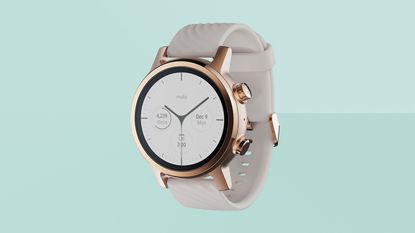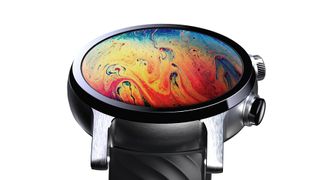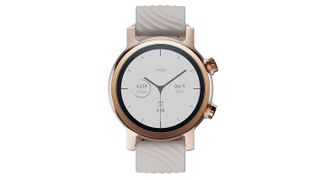Moto 360 (3rd Gen) review: a very good Wear OS watch tinged with nostalgia
The redesigned Moto 360 smartwatch is full of great features, but can't quite break away from the pack

The Moto 360 is a very good Wear OS smartwatch packed full of great features, but it can't break away from its contemporaries to challenge the very best smartwatches on the market
-
+
Attractive design, both modern and nostalgic
-
+
Good fitness tracking functionality
-
+
Great battery life, with time-only mode lasting days
-
-
No in-built speaker
-
-
Some health metric discrepancies
-
-
Upper-tier price
Why you can trust T3

Welcome to T3’s Moto 360 3rd generation review. We’ve gone hands-on with the Wear OS smartwatch to tell you everything you need to know about its design, performance, battery life, features and fitness tracking capabilities.
The Moto 360 was one of the first big smartwatches to debut back in 2014 sporting the Android Wear OS. Infamous for its circular face and the “flat tyre” bottom bezel, there’s a certain amount of nostalgia for this flawed, yet much-loved wearable.
It was brought back for a second generation in 2016, and now it’s been brought back again, but not by Motorola proper. The Moto 360 name and branding has been licensed out to a firm called eBuyNow, a self-described “independent, data-driven consumer electronics company”.
- Just in: iPhone 13 leak reveals how Apple intends to counter-attack Samsung Galaxy S30
- Best smartwatches
However, even though Motorola isn’t directly involved with production this go-round, what we’ve ended up with is a pretty good example of a typical current-generation Wear OS watch.
There’s a few design issues and omissions which would be required to bring it up to the standards of some of the top-tier Android offerings like the Samsung Galaxy Watch line, but it’s a well-made wearable nonetheless.
Moto 360 review: design

The Moto 360’s face has a 42.8mm diameter, including bezels, and the casing is 11.68mm deep. It’s a robust, chunky watch, but not to the point where it’s obtrusive or gaudy: it’s just over 1mm thicker than the Samsung Galaxy Watch Active, and still maintains a classic-looking streamlined watch design. At a glance, you wouldn’t even know it was a smartwatch.
Weighing in at 52g without the strap, it’s got a satisfying heft to it. The stainless steel casing arrives in three colours: phantom black, steel gray or rose gold.
Two crown buttons adorn the right-hand side of the watch, with the upper button acting as a scroll. It’s not the most revolutionary design in the world, but the scroller remains ergonomic, efficient and easy-to-use.
The 1.2” circular AMOLED screen is clear and bright, with no problem being seen in direct sunlight whatsoever. A significant bezel all around the watch face is quite noticeable, but flows a lot better than the “flat tyre” of previous incarnations. The bezel is all black: if you chose a black watch face, as we did, the bezel is almost invisible when glancing directly at the front of the watch, as you’ll be doing most often while using it. However: choose a coloured watch face like Astral or Time-lapse, and the bezel is much more noticeable.

This isn’t a flaw with the Moto 360 alone: many smartwatches struggle with the bezel requirements, and have to hide them in innovative ways. Apple Watch’s rectangular “pebble” shape initially scrolled vertically to hide wider bezels either side of the screen. All that technology’s got to go somewhere.
The watch comes with two different 20mm straps, leather and silicone – one for workouts and another for daywear. The colours of these straps depend on which watch you buy: the rose gold, the one we tested, comes with white silicone and brown leather.
We found ourselves using the silicone much more: the watch is water-resistant to 3ATM, so with the silicone strap, the wearer can go from workout to shower to sleep without worrying about degrading the leather. The straps are an easy snap fit, so can be swapped quickly and easily.
Moto 360 review: price
The Moto 360 was launched with an RRP of £299 / $299. You can find the best deals on the current Moto 360 below:
Moto 360 review: performance and fitness tracking

The Moto 360’s Qualcomm Snapdragon 3100 Wear chipset is standard across current-gen Wear OS watches, carried by the Moto 360’s contemporaries such as the Fossil Gen 5. The chipset supports Android Pay, Bluetooth 4.2 and 802.11n Wi-Fi, alongside the standard suite of Wear OS features. Its enhanced ambient mode allows the Moto’s excellent AMOLED display to really shine, while the screen kicks into life very easily: during our two weeks, not once did we have to do the “wrist shake” to light the watch up.
This is the result of the excellent batch of sensors packed into the Moto 360. The gyroscope and accelerometer accurately tracks the watch’s movements, working with the GPS and Galileo positioning support for accurate pace tracking without using your phone. I found no complaints, with the tracker mapping my local running route very closely to Strava’s usual distance measurements.
The watch works well enough to go on runs without the phone, with 8GB of memory holding plenty of music. However, we used the Moto 360 on runs in conjunction with our phone’s Spotify and Strava apps for Wear OS, and it served just as well.

Heart rate readings were comparable to other smartwatches tested during workouts. However, while wearing the watch day-to-day, we found the heart rate sensor would record intermittently, with small, irregular gaps throughout the day.
The base software on Wear OS is Google Fit, which uses Heart Points (each heart point is approximately one minute of exercise) and a separate “active minutes” metric.
These were fairly incongruent: the watch begins at base targets of 10 Heart Points, which can be achieved with a ten-minute walk, but that’s only a fraction of Google Fit’s sixty recommended minutes.
To somebody looking for a smartwatch to begin a health regime, this could be an early stumbling block. This is more a Wear OS criticism than a point against the Moto 360, but Apple’s WatchOS and even the Huawei Health app offers more comprehensive goal-setting.
Moto 360 review: battery life

The Moto 360’s 355mAh battery is purported to last at least a full day, if not a day and a half. After a few weeks of wear, I’d say this is an accurate assessment. I’d frequently wear mine all day and all night to get my resting heart rate, only to remove it for charging around 3pm the next day. With more significant GPS use, such as a long run or cycle, expect to charge it early the following morning.
When battery life is critical, the Moto 360 slips into its time-only mode, which is said to be good for up to three days. That means even though it may lose certain functionalities, you’ll never be lost without an actual watch, which removes a good portion of wear anxiety and saves a lot of face when you’re asked for the time on the street. It’s a great mechanic, but it’s now a common feature in current-gen smartwatches.
The battery is also said to charge from 0-100% in sixty minutes, which our findings reflect. The charger provided is a magnetic snap-on USB charger, which does the job perfectly well, but for the price point, we’d really like to have seen wireless charging from the watch, which is one of the few things it lacks in addition to a speaker.
Moto 360 review: verdict
At a price of £299/$299, the Moto 360 smartwatch is a good, even great Wear OS watch. Those taken in by the nostalgia of the Moto 360 name and shape will feel right at home, as the iconic design has been updated in the best way: the sensors are accurate, the UI is easy to navigate and the information the watch provides is useful.
The design, while prominent, isn’t big and bulky, with the slick stainless steel and choice of colours leaves the user looking and feeling like they’re wearing a mechanical timepiece.
However, the Moto 360, although down from its initial price of £340/$340, is only an attractive prospect for those who know they want a Wear OS watch. If you’re dithering between other operating systems, such as the Apple Watch and its WatchOS or Samsung’s Tizen software, the Moto 360 can’t topple the others as the best in the game. The Moto 360 might be among the best Wear OS watches out there, but the nostalgia behind the name isn’t enough to break away from the pack.
Liked this?
Sign up to the T3 newsletter for smarter living straight to your inbox
Get all the latest news, reviews, deals and buying guides on gorgeous tech, home and active products from the T3 experts
Matt Evans now works for T3.com sister brand TechRadar, covering all things relating to fitness and wellness. He came to T3.com as staff writer before moving on, and was previously on Men's Health, and slightly counterintuitively, a website devoted to the consumption of Scotch whiskey. In his free time, he could often be found with his nose in a book until he discovered the Kindle.
-
 Your IKEA smart lights can now automatically adjust to match the time of day
Your IKEA smart lights can now automatically adjust to match the time of dayThe new dynamic lighting mode is available now
By Lizzie Wilmot Published
-
 Amazon Alexa’s most asked questions revealed – AI and celebrity heights had a starring role
Amazon Alexa’s most asked questions revealed – AI and celebrity heights had a starring roleAlexa! What were your most asked questions of 2024?
By Bethan Girdler-Maslen Published
-
 Apple plans to nuke the notch in its MacBook Pros
Apple plans to nuke the notch in its MacBook ProsThe most divisive feature since the Touch Bar is reportedly on the chopping block
By Carrie Marshall Published